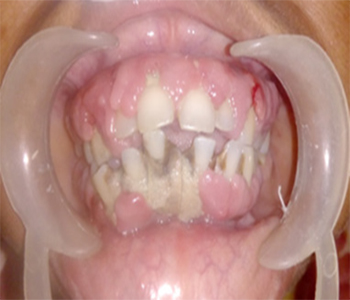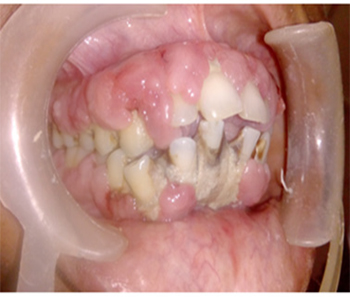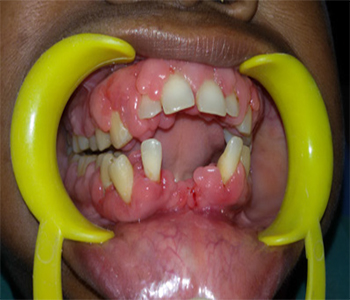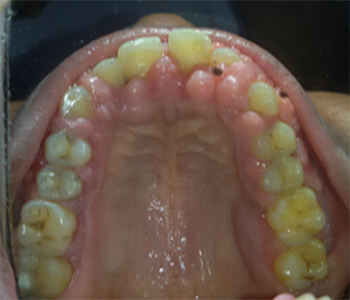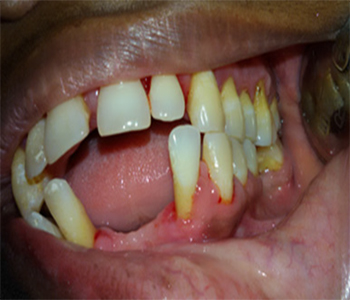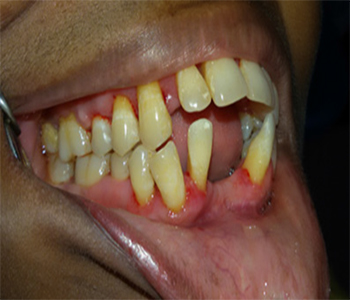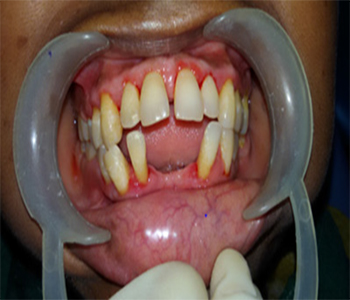Previous Issues Volume 2, Issue 1 - 2017
Amlodipine Induced Gingival Enlargement: A Case Worth Noting
Ameet Mani1, Shivani Sachdeva2*, Ankita Dalvi3, Raju Anarthe4
1Professor at Pravara Rural Dental College and Hospital, Loni, Maharashtra.
2Associate Professor at Pravara Rural Dental College and Hospital, Loni, Maharashtra.
3Pravara Rural Dental College and Hospital, Loni, Maharashtra.
4Reader at Pravara Rural Dental College and Hospital, Loni, Maharashtra.
Corresponding Author: Shivani Sachdeva, Department of Periodontics, Pravara Rural Dental College and Hospital, India, Tel: 09730548805; E-Mail: [email protected]
Received Date: 14 Dec 2016 Accepted Date: 29 Dec 2016 Published Date: 03 Jan 2017
Copyright © 2017 Sachdeva S
Citation: Sachdeva S, Mani A, Dalvi A, and Anarthe R. (2017). Amlodipine Induced Gingival Enlargement: A Case Worth Noting. Mathews J Case Rep 2(1): 023.
ABSTRACT
Gingival overgrowth is a frequently overlooked side effect associated with three major classes of drugs namely, anticonvulsants, calcium channel blockers, and immunosuppressants. Calcium channel blockers are widely used for the management of cardiovascular disorders of which Amlodipine, is being most commonly used, because of its duration of action. Here we describe a rare case of amlodipine-induced massive gingival hyperplasia and its management.
KEYWORDS
Hypertension; Amlodipine; Gingival Enlargement; Gingivectomy.
INTRODUCTION
Gum enlargement or overgrowth has multiple causes. Drugs being the most common offender. The preferred term for all medication-related gingival lesions previously termed “gingival hyperplasia” or “gingival hypertrophy” is gingival enlargement or gingival overgrowth. Drugs associated with gingival enlargement can be broadly divided into three categories: I. Anticonvulsants: Phenytoin II. Calcium channel blockers: Nifedipine, Amlodipine, Nicardipine III. Immunosuppressant’s: Cyclosporines Calcium channel blockers are widely used in medical practice for the management of cardiovascular disorders. Of this large group of drugs, the dihydropyridines are the agents most frequently used. Seymour et al in 1994 first reported of gingival overgrowth as a side effect of Amlodipine which was a newer agent of dihydropyridine, used for treatment of hypertension and angina [1,2]. A rapid development of gingival hyperplasia was seen in patients who received 10 mg per day of amlodipine within two months of onset [3].
Pharmacological Profile (Amlodipine) • Long acting dihydropyridine (other members: nifedipine, nicardipine, isoradipine, nitrendipine & felodipine). • Mechanism of action: coronary and peripheral arterial vasodilatation. • Dosage: 2.5 or 5 grams, single dose (alone or in combination with Atenolol). • Adverse effects: headaches, facial flushing, dizziness, oedema, gingival hyperplasia • Oral effects: detectable in gingival crevicular fluid • Significant sequestration of drug in in patients exhibiting gingival overgrowth [4]. Although the incidence of gingival enlargement associated with amlodipine was reported to be much lesser than nifedepine, recently large numbers of cases are being displayed [5]. Here, we report a case of amlodipine-induced gingival enlargement in a 58-year-old diabetic hypertensive patient taking amlodipine at a dose of 10 mg twice daily since 7 years.
CASE REPORT
A 58-year-old, female patient reported to Department of Periaodontics Rural Dental College, PMT, Loni, with the chief complaint of enlargement of gums since last three years. History revealed that the patient was diabetic and hypertensive, suffering from chronic renal disease secondary nephrolithiasis and was on medication for the same since past 7 years. At six months, the patient noticed the gingival enlargement and intermittent bleeding of the gums. Furthermore, she noticed gradual increase in spacing between her upper and lower anterior teeth with associated mobility with the same. On intraoral examination, both the maxillary and mandibular arches had enormous overgrowth of overlying soft tissue (Figure- 1(a, b)) was present. The soft tissue overgrowth was nodular and erythematous in appearance and showed spontaneous bleeding on touch and was painful. Local factors (supra and subgingival calculus) contributing to the inflammation were also present. Medical and drug history of the patient revealed that patient was known diabetic and hypertensive and was on medication since last 7 years (Insulin mistard 30-0-18, Amlodipine 10 mg twice daily).
Figure 1(a): First Visit - Frontal view.
Figure 1(b): First Visit – Lateral View
Routine blood investigation values were in normal range including bleeding time, clotting time and blood sugar level (Random). Based on Patients history, clinical evaluation and radiographic assessment a provisional diagnosis of amlodipine induced drug enlargement superimposed with inflammation was established.
NON-SURGICAL PROTOCOL
Patient was referred to physician for his consent and consideration for substitution of drug (amlodipine) with other antihypertensive drug, for which the physician agreed and substituted amlodipine with angiotensin receptor blocker. Scaling and root planning was done for both the arches followed by extraction of mandibular incisors, which were Grade III mobile. Patient was asked to rinse with 10 ml of 0.2% chlorhexidine mouthwash twice daily for one minute, oral hygiene instructions were given and she was asked to maintain strict oral hygiene. She was asked to report back after two weeks. The tissue in the mean time had become fibrous (Figure-2(a, b)) and inflammation had subsided.
Figure 2(a): 1 week post scaling and root planning.
Figure 2(b): 1 week post scaling and root planning- Occlusal view.
SURGICAL TREATMENT
Internal bevel gingivectomy was performed under local anaesthesia with respect to maxillary and mandibular left quadrants (Figure-3) to remove the fibrous tissue surgically. The surgical sites were covered with periodontal pack and post operative instructions were given. Patient was asked to report back after one week for check up. She was prescribed anti-inflammatory analgesic drug for management of postoperative pain for five days.
Figure 3: week post surgery - Left Quadrants.
The following week, internal bevel gingivectomy was performed under local anaesthesia with respect to maxillary and mandibular right quadrants (Figure 4).
Figure 4: week post surgery - Right Quadrants.
Patient reported pain and discomfort in the surgically treated area, as the treated area was open and raw wound surface. Hence, no treatment was given on that visit but patient was asked to come for check-up once every week and to maintain meticulous oral hygiene. It was also observed that tissue was showing gradual regression in size on its own at each visit. Hence, no further surgical treatment was planned but patient was asked to maintain strict oral hygiene using 0.2% chlorhexidine mouthwash. Patient was observed weekly once for a period of next two months. On examination after two weeks (Figure-5), the overgrowth had subsided almost completely. Hence patient was referred to Department of Prosthodontics for partial denture rehabilitation.
Figure 5: weeks months post surgery.
BIOPSY REPORT
The tissues excised were duly sent for histo-pathological assessment which exhibited the presence of parakeratinized epithelium with acanthosis and elongated rete-pegs, mixture of dense and loose fibrous connective tissue with inflammatory cell infiltration in connective tissue, few scattered giant cells and capillaries indicating a superimposed inflammation. This confirmed our diagnosis of drug induced gingival enlargement.
DISCUSSION
As stated earlier amlodipine is a second-generation dihydropyridine calcium channel blocker that can result in gingival hypertrophy as a side effect. The prevalence of amlodipineinduced gingival hypertrophy has been shown to be between 1.7% and 3.3% [6, 7]. The incidence of gingival hypertrophy with nifedipine therapy has been reported to be as high as 20% while that with the use of calcium channel blockers might be as high as 38% [8]. Gingival hypertrophy is 3.3 times more common in men than in women [9]. The most common form is bacterial plaque-induced gingival disease, which presents as gingivitis. Use of phenytoin, cyclosporine, and calcium channel blockers, as well as vitamin C deficiency, can also cause the condition, as can hormonal shifts during pregnancy. The reason for this adverse event is not absolutely known, but mechanisms involving inflammatory and non-inflammatory pathways have been suggested. For example, individual sensitivity to a drug's metabolic pathway might be a trigger [10]. Untreated gingival hypertrophy might lead to bleeding, infection, abscess, ulceration, cosmetic deficiency, and functional difficulty (eg, chewing, talking) [9]. Treatment of drug-induced gingival hypertrophy includes cessation of the inducing drug, its replacement if need be and decreasing other risk factors with meticulous mechanical and chemical plaque control. Surgical approach viz gingivectomy (excision of excessive gingival tissue) should be scheduled for severe cases that affect functionality or oral hygiene technique, or can be performed for aesthetic demands of the patient.
CONCLUSION
Gingival overgrowth is a potentially noxious side effect of amlodipine which is usually overlooked by physicians. Dental Surgeons need to discuss this issue with their medical colleagues and to practice care while prescribing the drugs associated with gingival overgrowth. Patients must be informed of the tendency of certain drugs to cause gingival enlargement and the associated oral changes and the importance of effective oral hygiene.
REFERENCES
- Jose J, Santhosh YL, Naveen MR, and Kumar V. (2011). Case report of amlodipine induced gingival hyperplasia - late onset at a low dose. Asian J Pharm Clin Res. 4(2): 65-66.
- Seymour RA, Ellis JS, Thomason JM, Monkman S, et al. (1994). Amlodipine induced gingival overgrowth. J Clin Periodontal. 21: 281-283.
- Lafzi A, Farahani RM, and Shoja MA. (2006). Amlodipine induced gingival hyperplasia. Med Oral Patol Oral Cir Bucal. 11: 480-482.
- Ellis JS, Seymour RA, Monkman SC, and Idle JR. (1992). Gingival sequestration of nifedipine induced gingival overgrowth. Lancet. 339(8806): 1382-1383.
- Dongari-Baqtzoglou A. (2004). Drug-Associated Gingival Enlargement. Research, Science and therapy committee, American Academy of Periodontology, Academy Report. J Periodontol. 75: 1424-1431.
- Jorgensen MG. (1997). Prevalence of amlodipine-related gingival hyperplasia. J Periodontol. 68(7): 676-678.
- Ellis JS, Seymour RA, Steele JG, Robertson P, et al. (1999). Prevalence of gingival overgrowth induced by calcium channel blockers: a community based study. J Periodontol. 70(1): 63-67.
- Nery EB, Edson RG, Lee KK, Pruthi VK, et al. (1995). Prevalence of nifedipine-induced gingival hyperplasia. J Periodontol. 66(7): 572-578.
- Prisant LM and Herman W. (2002). Calcium channel blocker induced gingival overgrowth. J Clin Hypertens (Greenwich). 4(4): 310-311.
- Tavassoli S, Yamalik N, Caglayan F, Caglayan G, et al. (1998). The clinical effects of nifedipine on periodontal status. J Periodontol. 69(2): 108-112.
